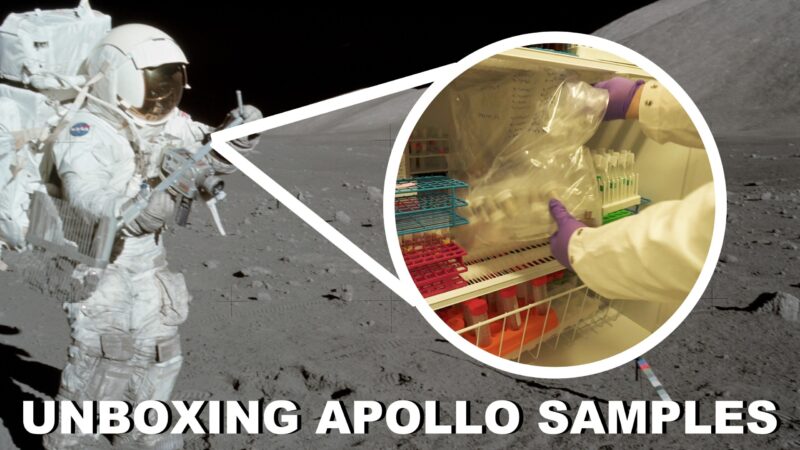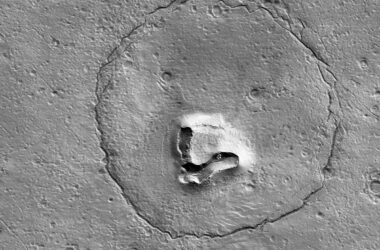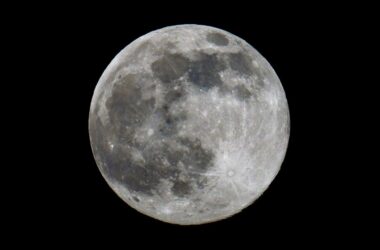
Un échantillon congelé d’Apollo 17 en cours de traitement dans une boîte à gants purifiée à l’azote au Johnson Space Center de la NASA à Houston. Cet échantillon est l’un des nombreux échantillons étudiés dans le cadre du programme ANGSA (Apollo Next Generation Sample Analysis Program). Crédit : NASA/Robert Markowitz
Les scientifiques de ;” data-gt-translate-attributes=”[{” attribute=””>NASA’s Goddard Space Flight Center in Greenbelt, Maryland, recently received samples of the lunar surface that have been carefully stored in a freezer at NASA’s Johnson Space Center in Houston since Apollo 17 astronauts returned them to Earth in December 1972.
This research is part of the Apollo Next Generation Sample Analysis Program, or ANGSA, an effort to study the samples returned from the Apollo Program in advance of the upcoming Artemis missions to the Moon’s South Pole.
Les scientifiques du Goddard Space Flight Center de la NASA à Greenbelt, Maryland, ont récemment reçu des échantillons de la surface lunaire qui étaient conservés dans un congélateur au Johnson Space Center de la NASA à Houston depuis que les astronautes d’Apollo 17 les ont ramenés sur Terre en décembre 1972. Crédit : Centre de vol spatial Goddard de la NASA
Cependant, le processus d’acheminement des échantillons de Johnson aux chercheurs de Goddard – ainsi qu’aux chercheurs du centre de recherche Ames de la NASA dans la Silicon Valley californienne, du Naval Research Laboratory à Washington, D.C., et de l’Université d’Arizona à Tucson – a été beaucoup plus difficile que vous ne le pensez. Le processus a commencé il y a plus de quatre ans, lorsque Julie Mitchell, de la NASA, et son équipe de conservation Artemis à Johnson ont commencé à concevoir et à réaménager une installation pour traiter les échantillons congelés d’Apollo 17. Il s’agissait d’une nouvelle approche et les scientifiques étaient enthousiastes à l’idée d’employer une technique qui pourrait être appliquée aux futures missions lunaires.
“Nous avons commencé cela au début de 2018 et il y a eu beaucoup de défis techniques que nous avons dû surmonter pour en arriver là”, a déclaré Mitchell. “Cela a été considéré comme un essai pratique pour préparer une installation pour le traitement futur d’échantillons froids.”
“En faisant ce travail, nous ne facilitons pas seulement l’exploration d’Artemis, mais nous facilitons le retour futur d’échantillons et l’exploration humaine dans le reste du système solaire”, a ajouté Mitchell. “Je me sens très privilégié de contribuer de cette petite façon en développant les capacités qui nous permettront de collecter ces matériaux, de les ramener en toute sécurité et de les conserver à long terme.”
Une fois que l’installation a été prête, Ryan Zeigler, conservateur des échantillons Apollo au sein de l’équipe d’Apollo. Division de la recherche sur les astromatériaux et de la science de l’exploration (ARES). à Johnson, et son équipe ont dû s’adapter aux conditions uniques conçues par l’équipe de Mitchell pour garder les échantillons congelés pendant le traitement, ce qui incluait une visibilité réduite à cause du gel et des défis pour manipuler les échantillons tout en travaillant avec des gants épais dans une boîte à gants purgée à l’azote, le tout à l’intérieur d’un congélateur-chambre maintenu à moins 4 degrés Fahrenheit (minus 20 C). Being able to keep samples frozen will be important for Artemis as astronauts potentially return ice samples from the Moon’s South Pole.
“Everything we do involves a lot of logistics and a lot of infrastructure, but adding the cold makes it a lot harder,” said Zeigler. “It’s an important learning lesson for Artemis, as being able to process samples in the cold will be even more important for the Artemis mission than it is for Apollo. This work gives us some lessons learned and a good feed forward for Artemis.”
Once the frozen samples were processed and subdivided at Johnson by lunar sample processor Jeremy Kent, the samples were then express shipped in a cooler with dry ice, immediately opened at Goddard, and stored in a secure freezer. For the scientists now working with the treasures, there’s something special about receiving samples that haven’t been investigated in nearly five decades.

Three ARES scientists process frozen Apollo 17 samples inside a walk-in freezer maintained at minus 4 degrees Fahrenheit (minus 20 C). Beneath the laboratory gown, they don parkas, gloves, and hats to keep warm. Credit: NASA/Robert Markowitz
Jamie Elsila, a research scientist in the Astrobiology Analytical Laboratory at Goddard, is focusing on the study of small, volatile organic compounds for her research and analysis of the sample. Previous research showed that some lunar samples contain amino acids, which are essential to life on Earth. Her team wants to understand their origin and distribution in the solar system.
“We think some of the amino acids in the lunar soils may have formed from precursor molecules, which are smaller, more volatile compounds such as formaldehyde or hydrogen cyanide,” said Elsila. “Our research goal is to identify and quantify these small organic volatile compounds, as well as any amino acids, and to use the data to understand the prebiotic organic chemistry of the Moon.”
Natalie Curran, principal investigator for the Mid Atlantic Noble Gas Research Lab at Goddard, focuses on understanding the history that the samples may have experienced during their lifetime on the Moon. The surface of the Moon is a harsh environment and unlike the Earth, it doesn’t have an atmosphere to protect it from exposure to space.
“Our work allows us to use noble gases, such as argon, helium, neon, and xenon, to measure the duration a sample has been exposed to cosmic rays, and this can help us understand the history of that sample,” said Curran. “Cosmic rays can be damaging to organic material that may be in a sample, so understanding the duration helps to determine the effects that exposure has had on the organic.”
Both Elsila and Curran are in possession of frozen and non-frozen lunar samples. When these samples were brought to Earth, a portion was stored at room temperature and another portion was frozen, allowing for comparison between the two groups. Scientists will analyze both sets of samples to ascertain if there are differences in the organic content. Understanding any variations caused by the different curation methods might inform future decisions about how to store samples returned by Artemis astronauts, part of what the ARES team at Johnson will be doing.
For Elsila, “it’s very cool to think about all the work that went into collecting the samples on the Moon and then all the forethought and care that went into preserving them for us to be able to analyze at this time,” she noted.
As for Curran, “when you think of how these samples have come from another world, how far they have traveled and the solar system history they have preserved inside of them, it always blows my mind,” she added.



